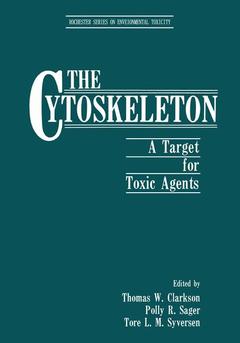The Cytoskeleton, Softcover reprint of the original 1st ed. 1986 A Target for Toxic Agents Rochester Series on Environmental Toxicity Series
Langue : Anglais
Auteurs : Clarkson Thomas W., Sager Polly R., Syversen Tore L.M.

This book is based on reviews and research presentations given at the 16th Rochester International Conference on Environmental Toxicity, entitled liThe Cytoskeleton: A Target for Toxic Agents," held on June 4, 5 and 6 in 1984. The conference provided an in-depth discussion of the effects a~d mechanism of action of some toxic agents on the cytoskeleton. Mamma"lian and other eukaryotic cells contain protein networks within the cytoplasm comprised of microfilaments, intermediate Hlaments and microtubules. These components of the cytoskeleton playa key role in cell shape, motility, intracellular organization and transport, and cell division. Furthermore, the cytoskeleton, via associations with the cell membrane, appears to function in intracellular communication and cellular responses to membrane events. Because of the complex functional roles of the cytoskeleton which vary with cell type, degree of differentiation, and cell cycle, its disruption may result in a variety of cellular changes. This expanding field in cell biology has already attracted the interest of toxicologists and environmental health scientists as a potentially fruitful area of research. Indeed, there is mounting evidence that certain toxic and chemotherapeutic compounds, as well as physical agents such as radiation and hydrostatic pressure, disrupt the normal structure and function of the cytoskeleton. This may be an important step in the overall expression of their action. It was, therefore, an opportune time to hold a conference to encourage the development of this area of toxicology and to suggest directions for future research.
Overview.- Structure and Function of the Cytoskeleton.- The Cytoskeleton as a Target for Toxic Agents.- Invited Papers.- Session 1. Microtubules and Microtubule Inhibitors.- Microtubules as Targets for Drug and Toxic Chemical Action: The Mechanisms of Action of Colchicine and Vinblastine.- Taxol: A Probe for Studying the Structure and Function of Microtubules.- Reorganization of Axonal Cytoskeleton Following ß, ß?-Iminodipropionitrile (IDPN) Intoxication.- Molecular and Cellular Aspects of the Interaction of Benzimidazole Carbamate Pesticides with Microtubules.- Disruption of Microtubules by Methylmercury.- Session 2. Cytoskeleton of the Nervous System.- Primary and Secondary Changes in Axonal Transport in Neurofibrillary Disorders.- Chemical Neurotoxins Accelerating Axonal Transport of Neurofilaments.- The Effect of Some Dithiocarbamates, Disulfiram and 2, 5-Hexanedione on the Cytoskeleton of Neuronal Cells InVivo and InVitro.- Neurofibrillary Degeneration: The Role of Aluminum.- Pathogenetic Studies of the Neurofilamentous Neuropathies.- Session 3. Cytoskeleton and membrane related events.- Effects of Calcium on Structure and Function of the Human Red Blood Cell Membrane.- Spectrin and the Mechanochemical Properties of the Erythrocyte Membrane.- Effects of Local Anesthetics and pH Change on the Platelet“Cytoskeleton” and on Platelet Activation.- Inhibition of Motility by Inactivated Myosin Heads.- Intracellular Translocation of Inorganic Particles.- Receptor Cycling in Pituitary Cells: Biological Consequences of Inhibition of Receptor-Mediated Endocytosis.- Conference Summary.- Perspectives.- Author Index.
Date de parution : 11-2011
Ouvrage de 261 p.
17.8x25.4 cm
Thème de The Cytoskeleton :
Mots-clés :
Calcium; Pathogene; cell biology; drug; environment; health; mercury; pesticide; pesticides; research; toxicity; toxicology; toxin; transport
© 2024 LAVOISIER S.A.S.
